| A | B |
|---|
| * The scientific study of the interactions between organisms and their environment is called _____. | ecology p.850 |
| ** Ecology is the scientific study of the interactions between ______ and ______. | organisms, their environment p.850 |
| *The intensity of sunlight that hits the Earth in any given place or season is determined by the ____. | angle that the sunlight strikes the surface of the Earth (Sunlight strikes the Earth most directly at the equator and the angle becomes lower as you move away from the equator. Winter is caused by the fact that due to the Earth's tilt, the angle that the sun strikes the parts of Earth experiencing winter is much lower than when it strikes the same places in summer. A 90 degree angle would be straight overhead. Many people falsely believe that the seasons are caused by the elliptical orbit of Earth around the sun. In the northern hemisphere, the Earth is actually closer to the sun in the winter) p.852,  |
| **Why do parts of the world around 30 degrees north and south latitude tend to have arid (dry) climates? | Air rises at the equator due to solar heating. As the air rises, it cools and releases a lot of moisture at the equator, but the now drier air starts travelling away from the equator. Around 30 degrees, either north or south of the equator, this dry air sinks back toward land. Sinking air warms as it comes under more and more pressure the closer it gets to the ground. Warm air can hold (the opposite of release) more water, so it rarely rains in these regions. p.852,  |
| **The windward side of a mountain range is usually ______ than the leeward side which is usually ____ due to the _____ effect | moister, drier, rainshadow effect p.852,  |
| ** During summer and winter, many lakes in temperate regions are ______ with little mixing of warmer layers with the cooler layers. In spring and fall, these lakes experience a phenomenon called ____ in which nutrient-rich water from the bottom rises to the surface and oxygen-rich water from the surface sinks to the bottom and mixing of all layers occurs. | thermally stratified, turnover (This concept is not longer in your book, but I still want you to know it because it helps you to understand why lakes can become anoxic and why cold oceans are nutrient rich), 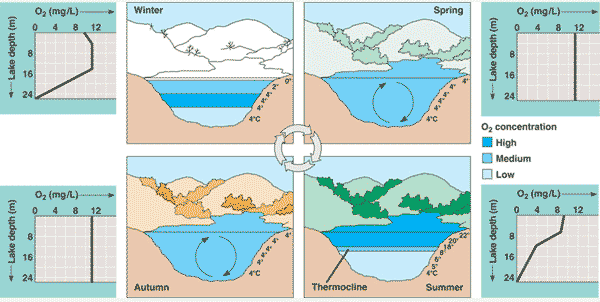 |
| * The upper part of an aquatic biome, where enough light penetrates for photosynthesis to occur, is called the ____. | photic zone p.859,  |
| * The lower layer of an aquatic ecosystem, which doesn't receive enough light to support photosynthesis, is called the _____ . | aphotic zone p.859,  |
* The bottom substrate of all aquatic ecosystems is called the ____ zone and the organisms that live there are called the ____., 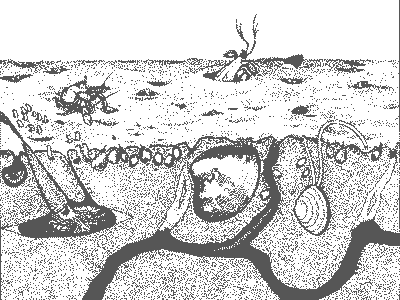 | benthic zone, benthos p.859,  |
| ** The zone of open water that includes both the photic and aphotic zone is called the _____ zone. | pelagic p.859,  |
** The pond in the picture below is classified as being ______ because of its murky (turbid) nutrient ____ water that supports a lot of life (especially algae).,  | eutrophic, nutrient-rich p.860,  |
** The lake in the picture below is classified as being ____ because of its clear nutrient ____ waters that support little photosynthetic life., 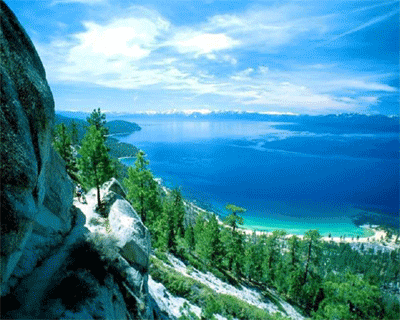 | oligotrophic, nutrient-poor p.860,  |
| ** The part of a lake that is shallow enough to support rooted aquatic plants is called the _____ zone. | littoral zone p.859,  |
| ** The part of a lake that is too deep to support rooted aquatic plants is called the _____ zone. | limnetic p.859,  |
** The layer of a lake that shows a rapid temperature change, as in the areas between the red lines in the graph and image below, is called a(n) _____., 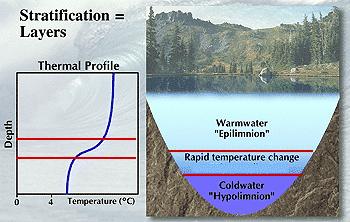 | thermocline (the thermocline separates the warm surface waters from the colder, denser, deep waters.) p.859, 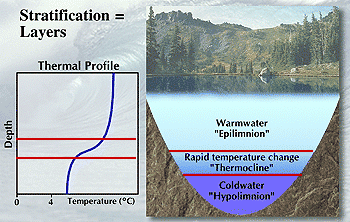 |
| ** A(n) ______ is a transition area between river and sea. | estuary p.859, 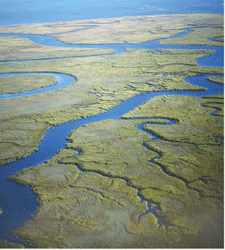 |
| * A(n) ______ is found where fresh and saltwater mix. | estuary p. 859,  |
* The picture below shows a tide pool in the _____ zone., 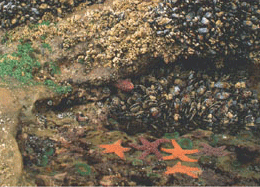 | intertidal zone p.860,  |
** The organisms in an intertidal zone, like the ones shown below, must be adapted to be able to survive wide ranges of _____ and _____.,  | water temperature and salinity (saltiness) p.860 *This is not something stated directly in this chapter, it is something you should be aware of.,  |
| ** The largest biome in the world is the ____. | oceanic pelagic biome (the open-ocean covers nearly 70% of the Earth) p.861,  |
* Which biome is shown in the picture below?,  | coral reef p.861,  |
* Coral reefs are found in ______ _______ waters.,  | warm clear p.861 (They have to be because the single-celled algae that live in the tissues of reef-building corals are a necessary symbiont for the coral animals and these algae wouldn't be able to survive in deeper waters due to lack of sunlight. Also, warm tropical waters are much clearer than colder waters for reasons you will learn about),  |
| * _____ largely determines the distribution and structure of terrestrial biomes. | Climate p.853 |
| ** ___________ lakes are generally oxygen poor. | Eutrophic (They are oxygen poor because even though they support a lot of photosynthetic algae, that algae dies on a regular basis, sinks to the bottom and is decomposed by bacteria which use a lot of oxygen) p.860,  |
** The graph below is called a(n) ______.,  | climograph p.855,  |
* According to the climograph, which factor is most important in determining whether an area will be a broadleaf forest versus a coniferous forest?,  | Average annual temperature (You find the dominant trees changing from broadleaf deciduous to conifers as you go north or up in elevation) p.855,  |
* According to the climograph, which factor is most important in determining whether an area will be a grassland versus a forest?,  | precipitation (Less precipitation causes a shift to grasslands. Even less precipitation would cause a grassland to turn into a desert) p. 1151,  |
| ** The area that marks a transition from one type of biome into another is called a(n) _____. | ecotone p.856 |
| ** What are the two main types of tropical forests and what is the main difference between them? | Tropical rain forest and tropical dry forests. The main difference is that in tropical dry forests, you have a dry season and a rainy season. Tropical rain forests are rainy pretty much year around. p.856 |
* Which biome is pictured below?,  | Tropical forest (The map shows the distribution of tropical forests. The picture is a tropical rainforest in Borneo) p.856,  |
* Which biome is pictured below?,  | Chaparral p.857,  |
* Which biome is pictured below?,  | Northern coniferous forest p.858,  |
* Which biome is pictured below?,  | Desert p.857,  |
* Which biome is pictured below?,  | Savanna p.856,  |
* Which biome is pictured below?,  | Temperate broadleaf forest (a.k.a. Temperate Deciduous Forests) p.858,  |
* Which biome is pictured below?,  | Temperate grasslands p.857,  |
* Which biome is pictured below?,  | tundra p.858,  |
| ** Another name for the northern coniferous forest is the ______. | Taiga (This term refers to the part of the biome that borders the tundra but still has conifers, though they are usually a bit on the stunted side due to the cold and wind) p.858,  |
| * Which terrestrial biome has the greatest biodiversity? | Tropical forests (biodiversity relates to the number of different species that can be found in an area) p.856,  |
| ** Which biome is very warm with a dry season that can last eight or nine months? | savanna p.856,  |
| ** Which biome is usually found close to the coast and has mild rainy winters and long dry summers? | chaparral p.857,  |
| * Which biome is characterized by short drought resistant trees and shrubs? | chaparral p.857,  |
| * Which biome is characterized by cold dry winters and hot humid summers? | temperate grasslands p.857,  |
| * Deciduous trees are trees that ______. | drop their leaves in the fall p.858,  |
| ** _________ trees are trees that drop their leaves in the fall. | Deciduous p.858,  |
| * You can find the tundra biome much further south than normal if you ______. | go up in elevation enough (up taller mountains) p.858 |
| * Which biome is characterized by a layer of permafrost just below the surface soils? | Tundra p.858,  |
| ** The tundra is characterized by a permanently frozen layer of soil just below the surface called _____. | permafrost p.858,  |
| ** The uppermost layer of vegetation in a terrestrial biome is called the _____. | canopy p.856,  |
| * A biome located throughout midlatitude regions where there is sufficient moisture to support the growth of large, broadleaf deciduous trees. | temperate broadleaf forest p.858,  |
| ** Very deep benthic zones (bottom of the ocean areas) are also called the _____ zone. | abyssal zone p.861,  |
| * Which biome is characterized by sparsely scattered individual trees and large herds of herbivores, large carnivores, and occasional fires and droughts? | savanna p.856,  |
| ** A highly productive lake, having a high rate of biological productivity supported by a high rate of nutrient cycling. | eutrophic lake p.860,  |
| ** A warm-water, tropical ecosystem dominated by the hard skeletal structures secreted primarily by the resident cnidarians. | Coral reef (The cnidarians they are talking about are hard corals like the brain coral pictured below. Notice the white patch of calcium carbonate skeleton that is exposed where the coral polyps have died) p. 861, 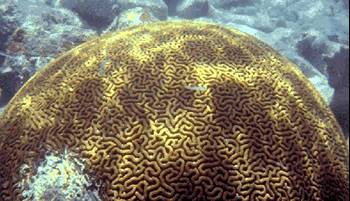 |
| ** The shallow region of the ocean overlying the continental shelf. | neritic zone (this diagram is not longer in your book, but I still want you to know it),  |
| ** A dark, hot, oxygen-deficient environment associated with volcanic activity. The food producers are chemoautotrophic prokaryotes. | Deep-sea hydrothermal vents. p.861 (chemoautotrophic bacteria that can use the simple chemicals coming out of the volcanic vents make up the bottom of the food chain in this ecosystem and is one of the few ecosystems that doesn't require light from the sun) p. 1162, 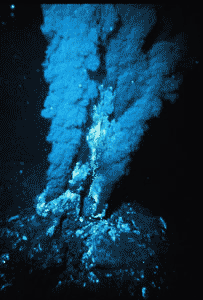 |
| ** The region of water lying over deep areas beyond the continental shelf. | oceanic zone p.861,  |
| ** A biome at the extreme limits of plant growth. At the northernmost limits, it is called ____, and at high altitudes, it is called ____. | arctic tundra, alpine tundra (no longer in your book, but I want you to know it) |
| ** A scrubland biome of dense, spiny evergreen shrubs found at midlatitudes along coasts where cold ocean currents circulate offshore; characterized by mild, rainy winters and long hot dry summers. | chaparral p.857,  |
| ** The community of organisms living on the bottom of an aquatic biome. | benthos p. 859,  |
| ** The mixing of waters as a result of changing water-temperature profiles in a lake. | turnover (no longer in your book, but I still want you to know it),  |
| ** In a lake, the well-lit, open surface waters farther from shore. | limnetic zone p.859,  |
| ** ______ is the long-term prevailing weather conditions in a given area. | Climate p.853 |
| * The _____ is the global ecosystem - the sum of all the planet's ecosystems and landscapes. | biosphere p. 851 |
| * A(n) ______ is the community of organisms in an area and the physical factors with which those organisms interact. | ecosystem p. 851 |
| ** An ecosystem is the community of organisms in an area and the _________ with which those organisms interact. | physical factors p. 851 |
| * An ecosystem is the __________ of organisms in an area and the physical factors with which those organisms interact. | community p.851 |
| * A(n) ____ is a group of populations of different species in an area. | community p. 851 |
| * A(n) ____ is a group of individuals of the same species living in an area. | population p.851 |
| ** What are the four most important abiotic factors in determining climate? | temperature, precipitation, sunlight, and wind p.853 |
| ** Patterns of climate on a very fine scale, that differ from the surrounding climate, such as specific climate conditions underneath a fallen log, or those next to a waterfall, are referred to as ________. | microclimate (no longer in the book, but I still want you to know it) |
| *The living factors in an environment are called ____ factors. | biotic pp.853&863 |
| *The non-living factors in an environment are called ____ factors. | abiotic pp.853&863 |
| ** Many of the world's deserts are found around _____ degrees north and south of the equator, where dry descending air masses occur. | 30 (This is due to the fact that air circulating in the atmosphere tends to descend at these latitudes. The air has already released most of its moisture near the equator. Air warms as it descends, making it even less likely that condensation will occur) p.852,  |
| ** What type of biome is usually found 30 degrees north or south of the equator? | deserts (This is due to the fact that air circulating in the atmosphere tends to descend at these latitudes. The air has already released most of its moisture near the equator. Air warms as it descends, making it even less likely that condensation will occur) p.852,  |
| * _______ are major life zones characterized by vegetation type (in terrestrial ones) or physical environments (in aquatic ones). | Biomes p.854 |
| ** Terrestrial biomes are characterized by the predominant type of ______ found there. | vegetation p.854 |
| *______ biomes are aquatic biomes with salt concentrations somewhere around 3% while _____ biomes have salt concentrations near or below 0.1%. | Marine, freshwater p.859 |
| * Oceans cover about ____ of the planet's surface. | 75% p.859 |
| ** The headwaters of a river are found furthest ______. | upstream (include the smaller fast flowing streams up in the mountains that join into larger and larger streams and rivers flowing toward the mouth of the watershed near the ocean) p.860 |
| ** The mouth of a river is located farthest ____. | downstream (where the river meets the ocean) p.860 |
| * Any organism that is not strong enough to swim against the current (and therefore basically floats and drifts) is referred to as ______. If they are photosynthetic, they are called _____. If they are heterotrophs, they are referred to as ____. | plankton, phytoplankton, zooplankton pp. 860, 861, 862, 885&886 |
| ** The largest terrestrial biome on Earth is the ____. | Northern Coniferous Forest p.858,  |
| ** The movement of individuals away from their area of origin is known as ______. | dispersal p.862 |
| **The root word "a-" means ___. | without (example - "asexual" means "without sex") |
| ** The root word "geo-" means ___. | The Earth (example - Geology is the study of the Earth) |
| ** The root word "inter-" means ___. | between (example - the intertidal zone is the zone of beach that lies between high tide and low tide) |
| ** The root word "limn-" means ___. | lake (example - Limnology is the study of lakes. The limnetic zone the well-lit, open surface waters of a lake farther from shore) |
| ** The root word "eu-" means ___. | good, well (example - Eutrophic refers to an aquatic system with good amounts of nutrients or food. "Troph" refers to food) |
| ** The root word "oligo-" means ___. | small, scant (example - An oligotrophic lake has little nutrients and food. "Troph" refers to food.) |
| ** The root word "micro-" means ___. | small (example: A microclimate is a climate that happens in a small area) |
| ** The root word "thermo-" means ___. | heat (example - a thermocline is a depth of a lake where the temperature changes rapidly. The root word "-cline" means slope. The graph of a thermocline shows a steep slope in temperature change in the depth where the thermocline occurs) |
| * The different seasons are caused by ______. | Earth's tilted axis (Sunlight strikes the Earth most directly at the equator and the angle becomes lower as you move away from the equator. Winter is caused by the fact that due to the Earth's tilt, the angle that the sun strikes the parts of Earth experiencing winter is much lower than when it strikes the same places in summer. A 90 degree angle would be straight overhead. Many people falsely believe that the seasons are caused by the elliptical orbit of Earth around the sun. In the northern hemisphere, the Earth is actually closer to the sun in the winter) p. 853, 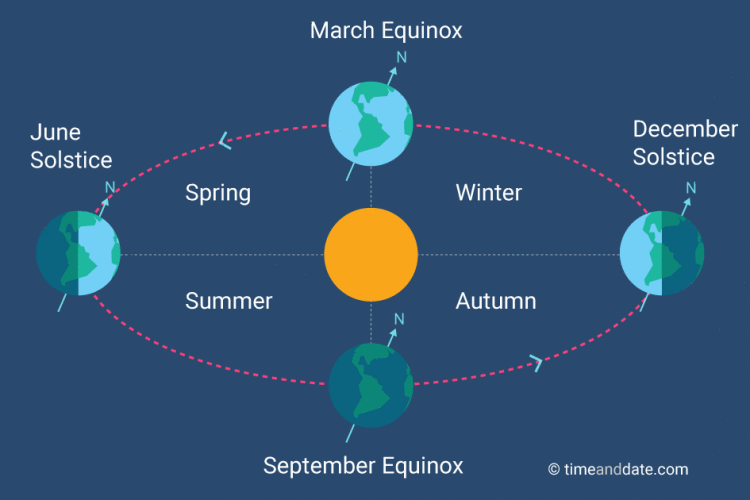 |
| **The lee side of a mountain range is usually ______ than the windward side which is usually ____ due to the _____ effect | drier, wetter, rainshadow effect p.854 p.852,  |
| ** Unlike terrestrial biomes, aquatic biomes are characterized by their _____ and _____ environments. | physical, chemical p.859 |
| ** Marine biomes are aquatic biomes with salt concentrations somewhere around ___ % while freshwater biomes have salt concentrations near or below ___ %. | 3, 0.1 |
| * The movement of organisms into a given area from another area is called ____. | immigration p.864 |
| * When organisms leave a certain area, the movement is called ___. | emigration p.865 |
| * For a population to grow, the ____ must be bigger than the ____ | birthrate must be larger than the deathrate (assuming no immigration or emigration) p.867 |
| * The number of individuals per unit area or volume is a population’s ____. | density p.864 |
| * Under ideal conditions with unlimited resources, a population will grow _____. | exponentially p.868 |
| **The graph of exponential population growth is describes as a(n) _____-shaped curve. | J-shaped curve p. 868 |
| ** The graph of logistical population growth is described as a(n) _____-shaped curve. | S-shaped curve pp. 869 & 870 |
* Which type of population growth does this graph show?,  | Exponential growth (Can only happens under ideal conditions with unlimited space, food and no predators) p.868,  |
* Which type of population growth does this graph show?,  | Logistic growth p.869,  |
* At which point in the graph below is the population growth rate accelerating?,  | Point A (The graph line should be more curved in an upward direction. It looks a little too linear, but I had a hard time drawing it that way) p.869,  |
* At which point in the graph below is the population growth rate the highest?,  | The population growth "rate" is the highest at point B. (You can determine the growth rate by finding the slope of the line tangent to the curve. Remember, slope = rise divided by run. In this case, the rise is the current population. The run is time. Dividing population by time gives you the population growth "rate.") p.869,  |
* At which point in the graph below is the population growth rate starting to slow down?,  | Point C p.869,  |
* At which point in the graph below is the population the highest?,  | The population is the highest at point D (look along the y-axis) p.869,  |
* At which point on the graph below is the population growth rate the lowest?,  | The population growth rate is lowest at point D (notice that the population, even though it is at its highest, has stopped growing) p.869,  |
* At which point in the graph below is the population at the carrying capacity?,  | Point D (Remember, the carrying capacity is the maximum number of individuals that the environment can support) p.869,  |
| * _______ is the study of the vital statistics of populations and how they change over time. | Demography p.866 |
| ** _____ is the pattern of spacing among individuals within the boundaries of the population. | Dispersion p.864 |
| ** Which two techniques for estimating population size are most commonly used by scientists? Under what circumstances would you use each one? | The sample plot method is used when the organisms are unlikely to move much (like trees). The mark-recapture method is used when individuals move about frequently (like fish). (From the masteringbiology.com activity called "Techniques for Estimating Population Density and Size ") |
| ** What is a possible source of error that must be taken into consideration when using the mark-recapture method for estimating population size? | A potential source of error for the mark-recapture method is the possibility that already marked individuals may be less likely to be trapped again if they become wary of the traps, or more likely to be recaptured again if they realize they can get free food and be released unharmed. (From the masteringbiology.com activity called "Techniques for Estimating Population Density and Size ") |
** Which type of dispersion pattern is shown below and which factors may account for this type of dispersion?,  | Clumped dispersion. Communal living explains clumped dispersion in wolf populations. Other types of organisms may be clumped in particular microhabitats, such as fungi. The mating habits of certain insects may explain a swarm that clumps large numbers of individuals together. p.865,  |
** Which type of dispersion pattern is shown below and which factors may account for this type of dispersion?,  | Uniform dispersion. Organisms that exhibit territoriality, or plants that give off chemicals to inhibit growth of neighboring plants often times have uniform distribution. p.865,  |
** Which type of dispersion pattern is shown below and which factors may account for this type of dispersion?,  | Random dispersion. Occurs in the absence of strong attraction or repulsion among individuals in the population or a uniform environment. In this case, the dandelions seeds were blown randomly across the field. p.866,  |
| ** The study of how complex interactions between biotic and abiotic factors influence variations in population size. | population dynamics p.873 |
| ** A plot of the number of members of a cohort that are still alive at each age. One way to graphically represent age-specific mortality. | survivorship curve p.866, 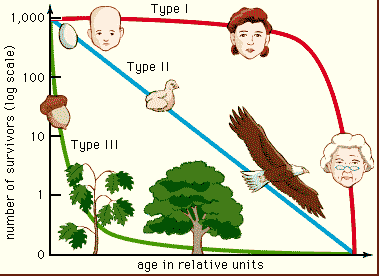 |
* Which survivorship curve would represent the human species? Which would represent a typical fish species?, 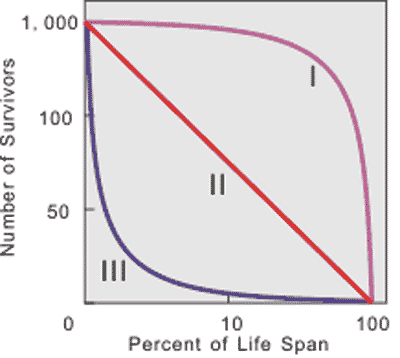 | Humans would be type I (due to their fairly high infant survival rate) Fish would be type III (because most lay many eggs and generally don't guard them or protect the juveniles, so most fish are eaten when they are small, if they even manage to make it out of their egg) p. 866,  |
| ** Selection that favors life history traits that maximize reproduction in uncrowded environments are called ____ selection. | r-selection p.872 |
| ** Selection that favors life-history traits that allow for survival under crowded competitive conditions is known as ____ selection. | K-selection p.872 |
| * The maximum population size that can be supported by the available resources, symbolized as K. | carrying capacity p.869 |
| ** A group of populations that are linked due to high rates of emigration and immigration. | metapopulation p.874 |
| ** A dispersion pattern in which individuals are aggregated in patches. | clumped dispersion p.865 |
| *Factors that affect either a birth-rate or death-rate as population in a given area increases are said to be _____. | density-dependent p.872 (Examples include competition, disease, and predation) |
| * A model describing population growth that levels off as population size approaches carrying capacity. | logistic population growth pp.869 & 870 |
| ** A behavior in which an animal defends a bounded physical space against encroachment by other individuals, usually of its own species. | territoriality p.873 |
| ** A(n) ______ is group of individuals of the same age that are studied for a long period of time. | cohort p.866 |
| ** A(n) ______ table is an age-specific summary of the survival pattern of a population. | life table p.866 |
| *Factors that affect either a birth-rate or death-rate, but do not increase in affect as an area increases in population are said to be _____. | density-independent p.872 |
| * Disease is a density-_____ factor that limits population growth. | density-dependent p.872 |
| * Harsh winters would be considered as density-______ factors that limit population growth. | density-independent p.872 |
| ** The word root "co-" means ___. | co- = together (cohort: a group of individuals of the same age, from birth until all are dead) |
** Which of these two age structure diagrams shows the typical human age structure of a typical third-world country?,  | A (This is from a masteringbiology.com activity called "Analyzing Age-Structure Pyramids"),  |
** Which of these two age structure diagrams shows the typical human age structure of a first world modernized country?,  | B (This is from a masteringbiology.com activity called "Analyzing Age-Structure Pyramids"),  |
** The age structure diagram on the left shows a ____ birth rate and a ____ death rate.,  | high birth rate and high death rate. (This is from a masteringbiology.com activity called "Analyzing Age-Structure Pyramids"),  |
** The age structure diagram on the right shows a ____ birth rate and a ____ death rate.,  | low birth rate and low death rate. (This is from a masteringbiology.com activity called "Analyzing Age-Structure Pyramids"),  |
| ** In human populations, ____ is a change from high birth rates and high death rates to low birth rates and low death rates. | demographic transition (This is from a set of masteringbiology.com activities on human population growth) |
| ** In human populations, the first stage of demographic transition is characterized by ___. | low death rate and high birth rate (Before the transition starts, you have high birth rates and high death rates. Third world countries start the demographic transition when health care and sanitation improve, decreasing the death rate) ** This is from a set of masteringbiology.com activities on human population growth |
| ** In human populations, demographic transition begins changes in society that ___. | lower the death rate (This is from a set of masteringbiology.com activities on human population growth) |